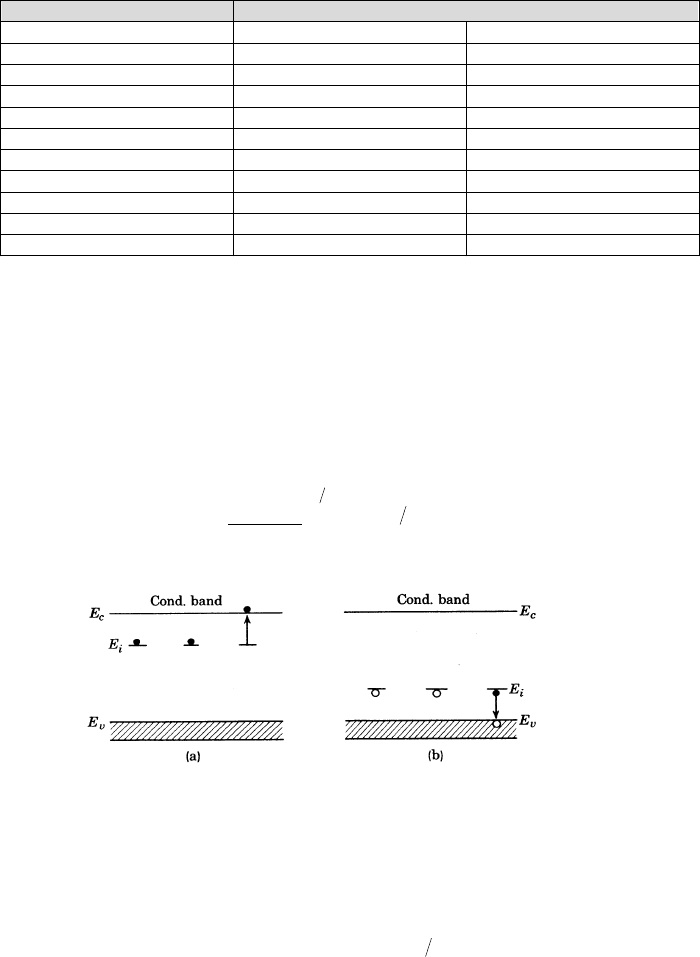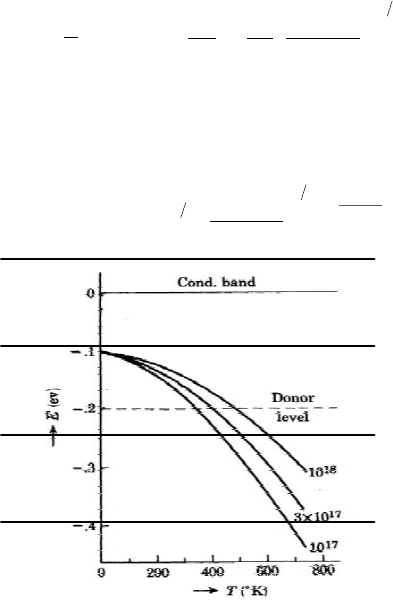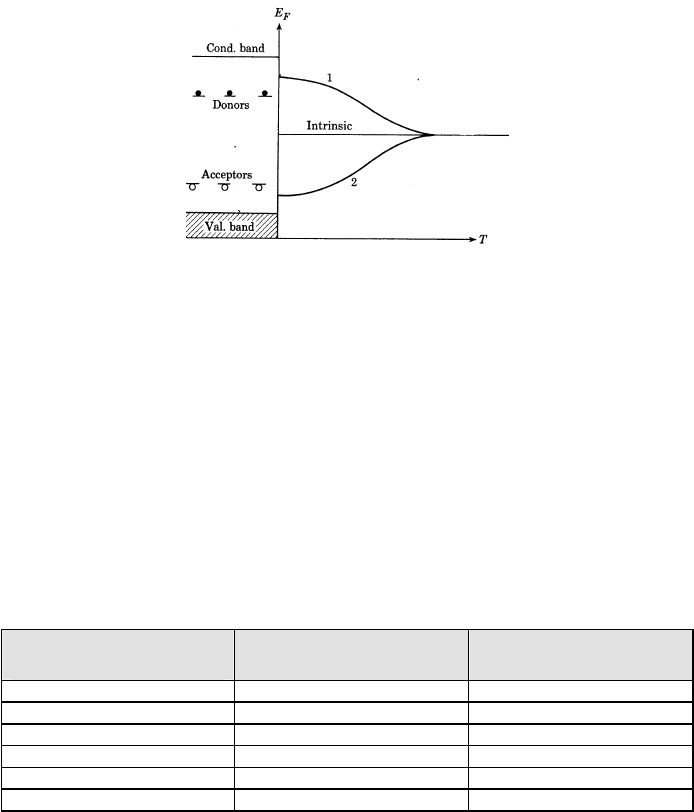Vij D.R. Handbook of Applied Solid State Spectroscopy
Подождите немного. Документ загружается.


12.6 Delocalized Systems
551
Assuming a Debye phonon distribution, and also that the energy difference
between electronic levels is greater than the phonon energies, equation (12.101)
reduces to
D
4
/
3
D
0
į
1
TT
i
x
Tx
EA dx
Te
§·
¨¸
©¹
³
, (12.102)
where Acc is a constant. A fit of this equation to lineshift data allows one to
determine the Debye temperature of the solid. We note the following:
1. Raman scattering involves the participation of real intermediate states.
For REI, these states include all unoccupied 4f-levels as well as those of
the upper configurations.
2. The experimentally observed shift is the difference in the energy shifts
of the two levels involved in the transition.
Experimental data show that lines shift generally toward the red, though blue
shifts are sometimes observed. Typically, the observed shift is on the order of 10
cm
–1
as the temperature is varied from 4 K to 500 K [42].
12.6.1 Density of One-Electron States and Fermi Probability
Distribution
Given a volume V = L
3
the number of one-particle states in the range dp
x
dp
y
dp
z
is
33
.
8ʌ
x
y
zx
y
z
VV
dk dk dk dp dp dp
h
(12.103)
The number of one-particle states in the range (p, p + dp) is
ʌ 2ʌ
22
33
00
4ʌ
sinșș
VV
g
pdp p dd dp pdp
hh
M
³³
(12.104)
and, if the particles are electrons, taking the spin into account,
2
33
3/2
1/2
3
22
4ʌ 12 4ʌ 12
22
22
4ʌ
2.
dp
g E dE g p dE
dE
VmV m
pdE mEdE
EE
hh
V
mEdE
h
(12.105)
Given a system of Fermions at temperature T, the probability distribution that
specifies the occupancy probability is
F
1
.
1
EE kT
FE
e
(12.106)
In metals E
F
, the Fermi energy, is the energy of the most energetic quantum
state occupied at T = 0. At T 0, E
F
is the energy of a quantum state that has the
cc
12.6 DELOCALIZED SYSTEMS

12. Luminescence Spectroscopy
552
probability 0.5 of being occupied. The number of available states in (E, E + dE)
for a system of electrons is
3/2
3/2
1/2
33
4ʌ 82ʌ
22 .
Vm
g
EdE m E dE VE dE
hh
(12.107)
The Fermi energy at T = 0 is determined by
F
3/2
1/2
3
00
3/2
3/2
F
3
82ʌ
=2
16 2ʌ
.
3
E
m
N
g
EdE V E dE
h
m
VE
h
f
³³
(12.108)
Then
2/3
22
22/3
F
0.121
3ʌ
2
Nh
E
n
mV m
§·
¨¸
©¹
=
(12.109)
where n = N/V.
12.6.2 Classification of Crystalline Solids
Crystalline solids are arranged in a repetitive 3D structure called a lattice. The
basic repetitive unit is the unit cell. Prototypes of crystalline solids are: (i)
copper—metal, (ii) diamond—insulator, and (iii) silicon—semiconductor. We
can classify the solid according to three basic properties:
1. Resistivity U at room temperature:
ȡ m
E
J
:
where E = electric field, J = current density.
2. Temperature coefficient of resistivity
1
1 ȡ
Į K
ȡ
d
dt
3. Number density of charge carriers, n (m
–3
).
The resistivity of diamond is greater than 10
24
times the resistivity of copper.
Some typical parameters for metals and undoped semiconductors are reported in
Table 12.3.
Table 12.3 A comparison of the properties of metals and semiconductors.
Property
Unit
Copper
(metal)
Silicon
(semiconductor)
n
–3
9 × 10
28
1 × 10
16
U:m
2 × 10
–8
3 × 10
3
D
K
–1
4 × 10
–3
–70 × 10
–3
1/2
m

553
If we assemble N atoms, each level of an isolated atom splits into N levels in
the solid. Individual energy levels of the solid form bands, with adjacent bands
being separated by gaps. A typical band is only a few eV wide. Since the
number of levels in one band may be on the order ~10
24
, the energy levels within
a band are very close.
12.6.2.1 Insulators
The electrons in the filled upper band have no place to go: The vacant levels of
the band can be reached only by giving an electron enough energy to bridge the
gap. For diamond the gap is 5.5 eV. For a state at the bottom of the conduction
band, the energy difference E – E
F
is 0.5E
g
, since, as we shall see later, the Fermi
energy for undoped semiconductors is approximately at the middle of the gap.
Therefore we have (E – E
F
) kT, and we can write for the probability that one
electron occupies a quantum level at the bottom of the conduction band as
g
F
F
2
1
.
1
E
EE kT
kT
EE kT
PE e e
e
|
(12.110)
At room temperature such a probability has the value
PE
e
5.5 2 0.026
|1.2 u10
46
and is negligible.
12.6.2.2 Metals
The feature that defines a metal is that the highest occupied energy level falls
near the middle of an energy band. Electrons have empty levels to which they
A classical free electron model can be used to deal with the physical
properties of metals. This model predicts the functional form of Ohm’s law and
the connection between the electrical and thermal conductivity of metals, but
does not give correct values for the electrical and thermal conductivities. This
deficiency can be remedied by taking into account the wave nature of the
electron.
12.6.2.3 Semiconductors
In this section we shall treat semiconductors that do not contain any impurity,
generally called intrinsic semiconductors. We shall see later how the presence of
impurities affects greatly the properties of semiconductors. The band structure
»
can go!
12.6 Delocalized Systems

12. Luminescence Spectroscopy
554
of a semiconductor is similar to that of an insulator: The main difference is that a
semiconductor has a much smaller energy gap E
g
between the top of the highest
filled band (valence band) and the bottom of the lowest empty band (conduction
band) above it. For diamond, E
g
= 5.5eV whereas for Si, E
g
= 1.1eV.
The charge carriers in Si arise only because, at thermal equilibrium, thermal
agitation causes a certain (small) number of valence band electrons to jump over
the gap into the conduction band. They leave an equal number of vacant energy
states called holes. Both electrons in the conduction band and holes in the
valence band serve as charge carriers and contribute to the conduction. The
resistivity of a material is given by:
2
ȡ
IJ
m
en
(12.111)
where m is the mass of the charge carrier, n is the number of charge carriers/V,
and
W is the mean time between collisions of charge carriers. Now, U
C
=2 × 1 0
–8
:, U
Si
= 3 × 10
3
:m, and n
C
= 9 × 10
28
m
–3
, n
S
= 1 × 10
16
m
–3
, so that
11
Si
Cu
ȡ
10
ȡ
and
13
Cu
Si
10 .
n
n
The vast difference in the density of charge carriers is the main reason for the
great difference in
U.
We note than the temperature coefficient of resistivity is positive for Cu and
negative for Si. The atom Si has the following electronic configuration
22 622
Si:1s2s2p3s3p.
core
Each Si atom has a core containing 10 electrons and contributes its 3s
2
3p
2
electrons to form a rigid two-electron covalent bond with its neighbors. The
electrons that form the Si-Si bonds constitute the valence band of the Si sample.
If an electron is torn from one of the four bonds so that it becomes free to
wander through the lattice, we say that the electron has been raised from the
valence to the conduction band.
12.6.3 Intrinsic Semiconductors
We shall now present a model for an intrinsic semiconductor. In general the
number of electrons per unit volume in the conduction band is given by
c
top
c
E
nNEFEdE
³
(12.112)
where N(E) = density of states and E
c
= energy at the bottom of the conduction
band.
We expect E
F
to lie roughly halfway between E and E
c
: The Fermi function
decreases strongly as E moves up in the conduction band. To evaluate the
integral in equation (12.112), it is sufficient to know N(E) near the bottom of
Q

555
the conduction band and integrate from E = E
c
to E = . Near the bottom of the
conduction band, according to equation (12.105), the density of states is given
by:
3/2
1/2
*
ec
3
4ʌ
2NE m E E
h
(12.113)
where
m
e
*
= effective mass of the electron near E
c
. Then
F
c
cF
F
1/2
3/2
c
*
c
3
1/2
3/2
*
e
3
4ʌ
2
1
4ʌ
2.
c
e
EE kT
E
c
EE kT
EE kT
E
EE
nm
h
e
EE
mdE
h
e
dE
f
f
²²
o
³
³
(12.114)
The integral may then be reduced to one of type
1/2
1/2
0
ʌ
2
f
³
x
xedx (12.115)
and we obtain the number of electrons per unit volume in the conduction band:
Fc
3/2
*
e
c
3
2ʌ
2 .
EEkT
mkT
ne
h
§·
¨¸
©¹
(12.116)
Let us now consider the number of holes per unit volume in the valence band:
V
h
bottom
1
E
nNEFEdE
ª
º
¬
¼
³
(12.117)
where E
v
= energy at the top of the valence band. 1 – F(E) decreases rapidly as
we go down below the top of the valence band (i.e., holes reside near the top of
the valence band). Therefore, in order to evaluate n
h
, we are interested in N(E)
near E :
3/2
1/2
*
hv
3
4ʌ
2NE m E E
h
(12.118)
where
*
h
m
= effective mass of a hole near the top of the valence band. For E
F
–
E
v
>> kT,
F
F
()
1
11
1
EE kT
F
EeEEkT
e
|
(12.119)
Substituting (12.118) and (12.119) into (12.117), we obtain
V
F
vF
h
bottom
3/2
1/2
*
h
3
3/2
*
h
2
1
4ʌ
2
2ʌ
2 .
E
E
EE kT
EEkT
nNEFEdE
mEEedE
h
mkT
e
h
f
ªº
¬¼
§·
¨¸
©¹
³
³
(12.120)
We now use the fact that
v
v
v
12.6 Delocalized Systems

12. Luminescence Spectroscopy
556
ch
nn
(12.121)
and equate the two expressions for n
c
and n
h
given by equations (12.116) and
(12.120), respectively. We find
*
cv
h
F
*
e
3
ln .
24
EE
m
EkT
m
(12.122)
If
eh
**
mm
, E
F
lies exactly halfway between E
c
and E
v
. Replacing equation
12.122 in the expression for n
c
= n
h
we find
g
3/2
3/4
**
2
ch eh
2
2ʌ
2
E
kT
kT
nn mm e
h
§·
¨¸
©¹
(12.123)
At room temperature,
3/2
3/2 19 3
2
2ʌ
210
kT
mcm
h
§·
|
¨¸
©¹
,
where m = mass of the electron.
12.6.4 Doped Semiconductors
12.6.4.1 n-Type Semiconductors
Consider the phosphorus atom’s electronic configuration:
22 623
P : 1s 2s 2p 3s 3p 15 .Z
If a P atom replaces a Si atom it becomes a donor. The fifth extra electron is
only loosely bound to the P ion core: It occupies a localized level with energy E
d
E
g
below the conduction band. By adding donor atoms, it is possible to
increase greatly the number of electrons in the conduction band. Electrons in the
conduction band are majority carriers. Holes in the valence band are minority
carriers.
Example: In a sample of pure Si the number of conduction electrons is
§10
16
m
–3
. We want to increase this number by a factor 10
6
. We shall
dope the system with P atoms creating an n-type semiconductor. At room
temperature the thermal agitation is so effective that practically every P
atom donates its extra electron to the conduction band.
The number of P atoms that we want to introduce in the system is given by
6
00P
10 nnn
,
or
66616223
P000
10 10 10 10 10 m .nnnn
| u
The number density of Si atoms in a pure Si lattice is
»

557
28 3
Si
510
a
N
nm
A
U
u
because N
a
= Avogadro number, U = density of Si = 2,330 kg/m
3
and A = molar
mass = 28.1g/mol = 0.028 kg/mol. The fraction of P atoms we seek is
approximately
22
P
28 6
Si
10 1
.
510 510
n
n
uu
Therefore, if we replace only one Si atom in five million with a phosphorous
atom, the number of electrons in the conduction band will be increased by a
factor of 10
6
.
12.6.4.2 p-Type Semiconductors
Consider the electronic configuration of an aluminum atom:
22 62
Al : 1s 2s 2p 3s 3p 13 .Z
If an Al atom replaces a Si atom it becomes an acceptor. The Al atom can bond
covalently with only three Si atoms; there is now a missing electron (a hole) in
one Al-Si bond. With a little energy an electron can be torn from a neighboring
Si-Si bond to fill this hole, thereby creating a hole in that bond. Similarly, an
electron from some other bond can be moved to fill the second hole; in this way
the hole can migrate through the lattice. It has to be understood that this simple
picture should not be taken as indicative of a hopping process, since a hole
represents a state of the whole system. Holes in the valence band are now
majority carriers. Electrons in the conduction band are minority carriers. We
compare the properties of an n-type semiconductor and of a p-type
semiconductor in Table 12.4.
12.6.5 Model for a Doped Semiconductor
Most semiconductors owe their conductivity to impurities, i.e., either to foreign
atoms put in the lattice or to a stoichiometric excess of one of its constituents.
Energy level scheme for an n-type semiconductor and a p-type semiconductor is
shown schematically in Figure 12.22.
12.6 Delocalized Systems

12. Luminescence Spectroscopy
558
Table 12.4 A comparison of the properties of an n-type and a p-type semiconductor.
12.6.5.1 n-Type Semiconductors
At T = 0 all the donor levels are filled. At low temperatures only a few donors
are ionized; the Fermi level is halfway between donor levels and the bottom of
the conduction band. If we assume that E
F
is below the bottom of the conduction
band by more than a few kT, then we can use in this case a formula similar to
equation (12.116) and find
Fc
32
e
c
2
2ʌ
2
EEkT
mkT
ne
h
§·
¨¸
©¹
(12.124)
Figure 12.22 Energy level scheme for (a) an n-type semiconductor, and (b) a p-type
semiconductor. E
i
is the energy of the donor level (a) or the acceptor level (b).
If E
F
lies more than a few kT above the donor level at E
d
, the density of
empty donors is equal to
Property
Type of Semiconductor
n P
Matrix material Silicon Silicon
Matrix nuclear charge 14e 14e
Matrix energy gap 1.2 eV 1.2 eV
Dopant Phosphorous Aluminum
Type of dopant Donor Acceptor
Majority carriers Electrons Holes
Minority carriers Holes Electrons
Dopant energy gap 0.045 eV 0.067 eV
Dopant valence 5 3
Dopant nuclear charge +15e +13e
dF
ddd
1.
EE kT
nFEne
ªº
|
¬¼
(12.125)

559
Equating (12.124) and (12.125) we obtain
32
e
Fdc
2
2ʌ
1
ln
222
d
nmkT
kT
EEE
h
ª
º
§·
«»
¨¸
«
»
©¹
¬
¼
. (12.126)
At T = 0, E
F
lies halfway between the donor level and the bottom of the
conduction band. As T increases, E
F
drops (see Figure 12.23). Putting the
expression for E
F
from equation (12.126) in n
c
given by equation (12.124), we
find
cd
34
12
e
2
cd
2
2ʌ
2.
EE
kT
mkT
nn e
h
§·
¨¸
©¹
(12.127)
Figure 12.23 The variation of the position of the Fermi level with temperature with a donor level
0.2 eV below the bottom of the conduction band for three different values of n
d
[43]
12.6.5.2 p-Type Semiconductors
The case of p-type semiconductors can be treated in a similar way. n
h
has an
expression similar to that for n
c
. The Fermi level lies halfway between the
acceptor level and the top of the valence band at T = 0. As T increases, E
F
rises.
Figure 12.24 represents schematically the behavior of the Fermi level for an
n-type and for a p-type semiconductor. The figure illustrates the fact that as the
temperature increases the Fermi level for an n-type semiconductor does not drop
indefinitely as indicated by (12.127). As the temperature increases the intrinsic
excitations of the semiconductor become more important and the Fermi level
tends to set in the middle of the gap. Similar effects take place for the p-type
semiconductor. For additional considerations, the reader is referred to the book
by Dekker (see bibliography at the end of this chapter).
12.6 Delocalized Systems

12. Luminescence Spectroscopy
560
Figure 12.24 The variation of the position of the Fermi level with temperature. Curve 1 relates to
insulators with donors and curve 2 relates to insulators with acceptors.
12.7 PROCESSES IN DELOCALIZED SYSTEMS
12.7.1 Direct Gap and Indirect Gap Semiconductors
The energy of the band gap of a semiconductor determines the spectral region in
which the electronic transitions, both in absorption and emissions, take place.
For visible or near infrared transitions we need materials with gaps ~1-1.7eV. A
list of such materials is provided in Table 12.5.
Table 12.5 A list of typical semiconductors.
Material
Type
Band Gap
(eV)
Si Indirect 1.16
InP Direct 1.42
GaAs Direct 1.52
GaP Indirect 2.3
AlP Indirect 2.5
SiC Indirect 3.0
Direct gap transitions take place when the maximum energy of the valence
band and the minimum energy of the conduction band both occur in
correspondence to a value of the linear momentum equal to zero or at the same
k
z 0. Such semiconductors are called direct gap semiconductors.
In other materials, the maximum of the valence band and the minimum of the
conduction band occur at different values of
k
. Such materials are called
indirect gap semiconductors.
It is interesting to consider the case of the semiconductor GaAs. By changing
the chemical composition of this material according to the formula GaAs
1–x
P
x
it
is possible to change the band gap from 1.52 eV with x = 0 to 2.3 eV with x = 1.
In addition, for x > 0.4 the material changes its character from that of a direct
G
G
